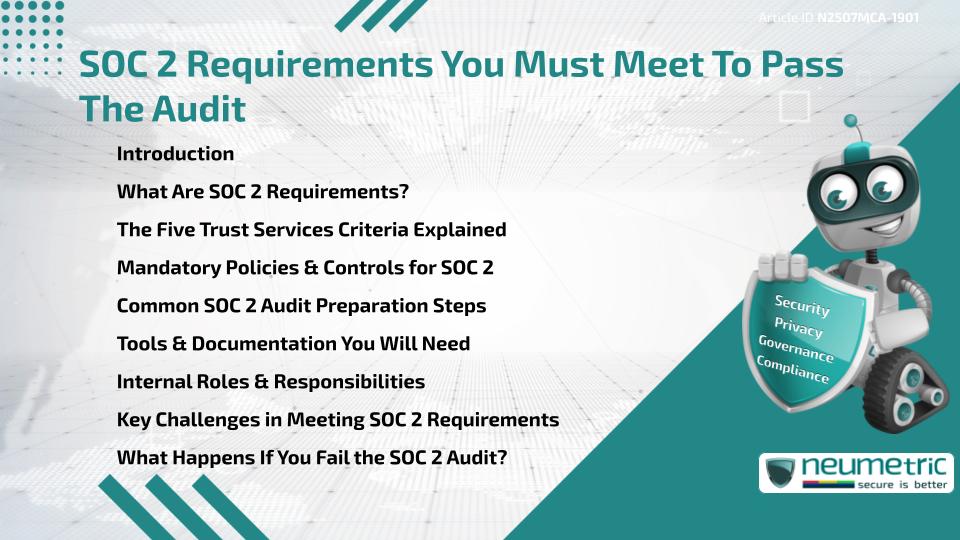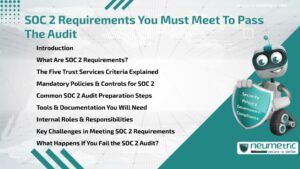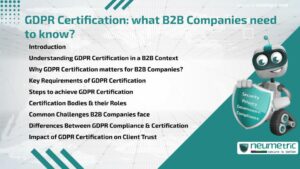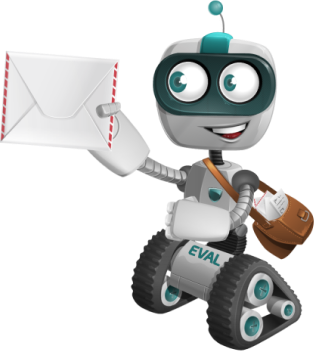Table of Contents
ToggleIntroduction
Meeting SOC 2 Requirements is essential for any service organisation handling Customer Data. Developed by the American Institute of Certified Public Accountants [AICPA], SOC 2 ensures companies operate securely, maintain Data Privacy & manage Risks effectively. To pass a SOC 2 Audit, an organisation must comply with a series of technical & operational criteria known as the Trust Services Criteria, alongside strong documentation, internal controls & clear accountability. This article outlines what SOC 2 Requirements are, how to meet them & what pitfalls to avoid during the Audit process.
What Are SOC 2 Requirements?
SOC 2 Requirements are a set of control criteria that determine how well a service organisation safeguards Customer Data & ensures Privacy. These criteria are built around five Core Principles:
- Security
- Availability
- Processing Integrity
- Confidentiality
- Privacy
Each principle includes a range of specific controls, Policies & procedures. Organisations are evaluated against these criteria by a licensed CPA [Certified Public Accountant] firm during an Audit. Importantly, SOC 2 is not a checklist but a Framework tailored to each business’s services & operational context.
The Five Trust Services Criteria Explained
Security
This is the foundational criterion & is included in every SOC 2 Audit. It focuses on protecting Systems & Data against unauthorised access, disclosure or damage.
Availability
Ensures that systems are available for operation & use as agreed upon. This includes performance monitoring, Incident Response & backup procedures.
Processing Integrity
Verifies that system processing is complete, accurate & timely. Controls often include input validation, error detection & data reconciliation.
Confidentiality
Deals with limiting access to data designated as confidential. Controls may include encryption, Access Control & secure data transmission.
Privacy
Focuses on the collection, use, retention & disposal of Personal Information. This typically aligns with Privacy laws such as GDPR or HIPAA.
Mandatory Policies & Controls for SOC 2
To pass a SOC 2 Audit, several Policies & controls must be clearly defined & implemented:
- Access Control Policy – Who can access what & under what conditions.
- Change Management Policy – Documenting how systems are modified safely.
- Incident Response Plan – How you detect & respond to Security Incidents.
- Risk Assessment Process – Regular evaluations of Threats & Vulnerabilities.
- Vendor Management Program – Ensuring Third Party compliance.
These documents serve as evidence during the Audit & must reflect actual practices.
Common SOC 2 Audit Preparation Steps
Preparation begins long before the actual Audit. Here’s what’s typically required:
- Conduct a Readiness Assessment to find gaps
- Assign internal owners for each Trust Services Criterion
- Collect documentation & logs
- Train staff on Policies & compliance expectations
- Set up automated alerts & Monitoring Tools
Companies often engage consultants or use SOC 2 readiness software to streamline the process.
Tools & Documentation You Will Need
Proper documentation is key to SOC 2 success. Some essential items include:
- Security awareness training logs
- Penetration Testing & Vulnerability scan results
- System architecture diagrams
- User access reviews
- Evidence of backups & system monitoring
Internal Roles & Responsibilities
SOC 2 compliance requires teamwork across departments:
- IT Teams – Maintain secure configurations & logging
- HR Teams – Ensure background checks & onboarding processes
- Executives – Approve Policies & allocate resources
- Legal – Align controls with applicable regulations
- Security Officers – Oversee Incident Response & compliance strategy
Clearly assigning responsibility ensures no gaps during the Audit.
Key Challenges in Meeting SOC 2 Requirements
Meeting SOC 2 Requirements is not always straightforward. Common difficulties include:
- Interpreting vague criteria
- Aligning legacy systems with modern Security Controls
- Maintaining ongoing compliance, not just for the Audit
- Keeping up with documentation
- Engaging every department equally
Understanding these challenges upfront helps teams plan proactively & avoid common missteps.
What Happens If You Fail the SOC 2 Audit?
Failing an SOC 2 Audit does not lead to penalties but may damage business credibility. The Audit report will show gaps or deficiencies, which can cause:
- Loss of Client trust
- Contractual issues with partners
- Delays in onboarding new clients
- Reputational harm
Fortunately, a failed Audit is also an opportunity. Companies can address the findings & request a follow-up Audit once issues are resolved.
Takeaways
- SOC 2 Requirements focus on protecting Customer Data through security, Privacy & process integrity.
- Five Trust Services Criteria form the basis of the Audit.
- Success depends on well-documented Policies, interdepartmental coordination & proactive planning.
- Challenges include unclear requirements, documentation overload & organizational silos.
- Preparing thoroughly & assigning internal accountability greatly increases Audit success.
FAQ
What does SOC 2 stand for?
SOC 2 stands for System & organisation Controls 2, developed by the AICPA for evaluating service providers on Data Security & Privacy.
Is SOC 2 mandatory for all companies?
No, SOC 2 is not legally required but is often essential for companies that store or process Customer Data, especially in B2B sectors.
How long does it take to prepare for a SOC 2 Audit?
Preparation can take anywhere from three (3) to twelve (12) months, depending on the maturity of existing controls & documentation.
Can a company fail a SOC 2 Audit?
Yes, if controls are not properly implemented or documented, a company can receive a qualified or adverse report.
What is the difference between SOC 1 & SOC 2?
SOC 1 focuses on Financial reporting controls while SOC 2 addresses security, Privacy & operational integrity.
Do all five Trust Services Criteria need to be included?
No, only Security is mandatory. The others-Availability, Processing Integrity, Confidentiality & Privacy-are optional based on business relevance.
Are automated tools necessary for SOC 2 compliance?
Not required, but tools can significantly simplify evidence collection, monitoring & control testing.
Who performs the SOC 2 Audit?
Only licensed CPA firms or Auditors associated with an AICPA-approved body can perform SOC 2 audits.
Need help for Security, Privacy, Governance & VAPT?
Neumetric provides organisations the necessary help to achieve their Cybersecurity, Compliance, Governance, Privacy, Certifications & Pentesting needs.
Organisations & Businesses, specifically those which provide SaaS & AI Solutions in the Fintech, BFSI & other regulated sectors, usually need a Cybersecurity Partner for meeting & maintaining the ongoing Security & Privacy needs & requirements of their Enterprise Clients & Privacy conscious Customers.
SOC 2, ISO 27001, ISO 42001, NIST, HIPAA, HECVAT, EU GDPR are some of the Frameworks that are served by Fusion – a SaaS, multimodular, multitenant, centralised, automated, Cybersecurity & Compliance Management system.
Neumetric also provides Expert Services for technical security which covers VAPT for Web Applications, APIs, iOS & Android Mobile Apps, Security Testing for AWS & other Cloud Environments & Cloud Infrastructure & other similar scopes. Reach out to us by Email or filling out the Contact Form…





